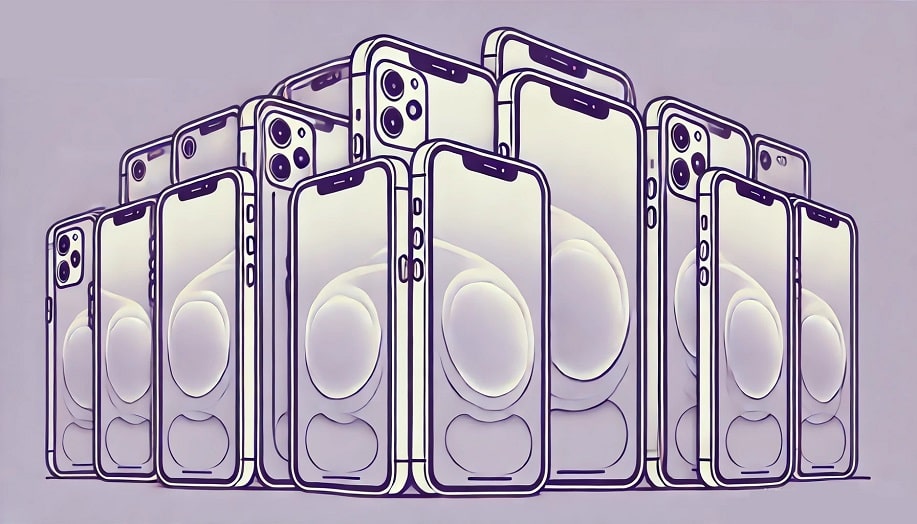In the ever-evolving landscape of smartphone tech, Apple continues to set a high watermark with each new iteration of the iPhone.
With the recent release of the
iPhone 16 and the introduction of the
iPhone 16e, many people are now considering whether to invest in Apple’s latest models or look at one of its recent predecessors. Here, we delve into the key differences between the iPhone 16, iPhone 16e,
iPhone 15,
iPhone 14, and
iPhone 13 to help you decide.
Design and Display:
The premium models of the iPhone 16 have a more dynamic display with a ProMotion refresh rate of up to 120Hz on the Pro and Pro Max models. This makes them smoother than the equivalent iPhone 15 handsets, which all had the 60Hz display, matching the base iPhone 16. All of the mentioned handsets offer ceramic shield protection for the screen, which improves durability and keeps it ahead of the competition for accidental drops. Good stuff!
While the iPhone 15 boasts a sleeker design with slightly slimmer bezels compared to the 14 and 13, the iPhone 16 pushes the design envelope further by reducing the notch and introducing Dynamic Island across its entire lineup (except for the 16e). The screens are also marginally larger on the iPhone 16 while maintaining the same overall device size thanks to reduced bezels.
The iPhone 16e, positioned as a more budget-friendly option, maintains the overall design of the iPhone 15 but introduces some refinements. It retains a 60Hz display but benefits from a slightly brighter panel than the base iPhone 15 models.
Overall, the iPhone 16 provides the most refined visual experience, particularly for gamers and people who want the best experience when watching videos and such.
⭐
Don’t forget, you can get iPhone insurance in three minutes with Protect Your Bubble.* We've got over 15,000 five-star reviews on Trustpilot and counting!** and you can SAVE 20% when insuring a phone purchased in the last 30 days***
⭐
Performance and Hardware:
The iPhone 16 range (including the 16e) is powered by the new A18 chip, which offers a noticeable leap in processing power, making it a dream for gamers, video editors, and multitaskers. It is rumoured to deliver 35% faster GPU performance and 20% better power efficiency compared to the A16 in the iPhone 15. That's quite a jump!
The iPhone 15 remains impressive with its A16 Bionic chip, outpacing the A15 chip found in both the iPhone 14 and iPhone 13. However, the iPhone 16 sets a new standard for speed and power efficiency, making it the top choice for important, demanding tasks (for example, insisting on leaving 460 tabs open on my browser).
Camera Capabilities:
Apple continues to focus on camera improvements. The iPhone 16 Pro models introduce a periscope telephoto lens, allowing for up to 6x optical zoom, compared to the iPhone 15’s 3x optical zoom. All models now have AI-assisted photography modes, including enhanced Portrait Mode and Smart HDR 5.0.
The iPhone 16e, while featuring a solid dual-camera system, lacks the periscope zoom but still benefits from AI-powered image enhancements and improved night mode compared to the iPhone 15.
The iPhone 15’s camera system, with its jump to a 48MP sensor, remains excellent for most users, but the iPhone 16’s advancements make it the most capable iPhone camera array to date, especially for low-light photography and videography.
Battery Life and Charging:
The iPhone 16 introduces faster 35W charging support, shaving minutes off the time to fully charge the device. Its battery life is also slightly improved, lasting around 12 hours in standard usage scenarios, an hour more than the iPhone 15. The iPhone 16e, with a slightly smaller battery, offers similar endurance to the iPhone 15 but lacks the fastest charging speeds of the iPhone 16.
Both outlast the iPhone 14 and 13, though the latter still punches above its weight.
Price and Availability:
The iPhone 16, as expected, commands a premium price, starting at £799, while the iPhone 16e starts at £699 as a more affordable entry into the latest generation. The iPhone 15 starts at £699, the iPhone 14 at £599, and the iPhone 13 at £449.
If budget is a concern, the iPhone 16e offers a compelling middle ground, bringing many of the iPhone 16’s design features at a slightly lower cost (though I've gotta say, it's a little bit disappointing that there isn't a newer 'mid-range' iPhone available now). The iPhone 13 continues to offer excellent value for money, but for those who want the best Apple has to offer, the iPhone 16 justifies its price with its cutting-edge features.
Is the iPhone 16, iPhone 16e, iPhone 15, iPhone 14, or iPhone 13 better?
In conclusion, the iPhone 16 leads the pack with significant advancements in performance, camera technology, and design. For those seeking the ultimate Apple experience, it’s the clear winner.
However, the iPhone 16e provides an appealing balance of price and performance, making it an excellent option for users who want some of the latest features without stretching their budget to the full iPhone 16 price tag.
The iPhone 15 still offers excellent value for those who want a powerful, modern phone without the higher price of the iPhone 16. The iPhone 14 and 13 remain solid options for users who prioritise affordability and don’t mind missing out on the latest features.
If photography or gaming is your focus, the iPhone 16 is ahead of the pack, while the iPhone 16e and 15 provide great middle-ground options. For everyday use, the iPhone 13 still delivers an exceptional experience at an unbeatable price.
You might also like:
PS5 vs PS5 Slim vs PS5 Pro: Which version of the PlayStation 5 should you go for?
Underwriter Assurant General Insurance Limited. Gadget age restrictions, T&Cs and excesses apply. Customer UK 18+.
** Trustpilot Score 4.3, 21,052 total reviews as of 13th February 2024.
*** Phones purchased in the last 30 days only. Valid when insuring 2 items or less.
